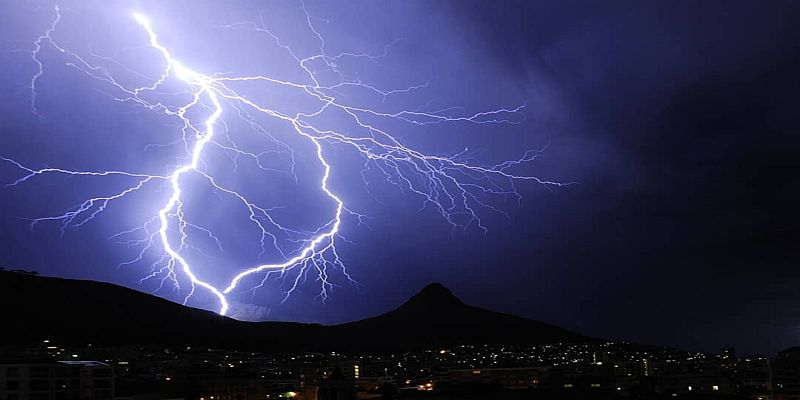When the Sky Speaks to the Soil: The Secret Work of Lightning and Thunder in the Farmer’s World

Before calendars and forecasts, farmers learned to read the weather like a sacred script. They watched the wind, listened to silence, and waited for the whisper before the roar. The land spoke, and those who worked it listened with their feet and their hearts.
It would start with a stillness. Smoke from morning fires refused to rise. Chickens paused their scratching. Goats sniffed the air. Even the frogs in shallow streams would sing at strange hours. There was a tension in the sky, like something holding its breath. When that happened, the old ones would nod slowly and say, “The sky is sharpening its teeth.”
Lightning wasn’t just fire. It was food. Thunder wasn’t just sound. It was signal.
Few today understand what truly happens when lightning splits the sky. That blinding bolt isn’t just lighting up the clouds it’s unlocking fertilizer from thin air. The heat of lightning, hotter than the surface of the sun, fuses nitrogen from the atmosphere with oxygen to form nitrates. These nutrients then dissolve in rainwater and fall gently to the soil. A free gift from the sky. No bag, no invoice, no factory just nature’s ancient contract with the earth. After such storms, crops often look greener, healthier, stronger. The soil responds like it’s been fed a secret meal.
That’s why, in the old days, farmers would wait for storm rain to plant leafy vegetables. That was the rain that carried the sky’s nutrients. The first flush after thunder wasn’t just wet it was rich.
Lightning Revives Dormant Seeds
The electric charge from lightning can stimulate dormant seeds in the soil, triggering germination. Some traditional farmers would even mimic this effect by lightly charring seeds before planting awakening their potential with fire, just as lightning does.
But the sky didn’t just speak to the soil. It also stirred the waters.
Lightning and the Fish Below
In lakes and dams, lightning plays yet another hidden role. The electrical discharge from a storm doesn’t just light up the sky it oxygenates surface waters. Sudden increases in oxygen levels stir up fish activity. In traditional fishing communities, elders would tell you: “After lightning, the fish rise.” That was the best time to cast nets or set traps. It wasn’t superstition it was biology. The agitation caused by the storm, combined with a flush of nutrients washed from the land, created feeding frenzies. Even fish know when the sky is giving.
Some believed you could feel lightning before it struck. Not just in the air, but in the bones. Elder women would say, “The air changes its taste.” Elder men would say, “When the birds go quiet, the earth is listening for the crack.” They weren’t guessing they were tuned.
And when it did strike, the tree it kissed wasn’t discarded. Its ash was crushed and scattered in fields. Its char was mixed into soil or even animal feed. Fire from above makes healing below. Today we call that biochar, a modern soil amendment praised for water retention and microbial health. Yet long before science caught up, the old farmer already understood: “The burnt branch holds medicine.”
Thunder told the farmer when to act. If it rumbled deep, rain was still far. If it cracked like a whip, rain was near. If it echoed and bounced, the storm would linger. Thunder before rain meant prepare. Thunder without rain meant watchful patience. Either way, it was a drumbeat to move the hand and sharpen the hoe.
In homes with thatched roofs and clay floors, children would learn these things not by lesson but by rhythm. They knew to pull in drying grain when the sky turned silver. They knew to cover manure pits when clouds stacked high. They knew that the loudest rains brought the gentlest food for plants.
Lightning could destroy. It could scorch a field, kill a cow, even start a fire that burned all night. But it could also wake the seeds sleeping just below the surface. It could feed the maize without a single top dressing. It could charge the soil with energy no bag of fertilizer could mimic.
And so, the wise farmer never feared lightning. They prepared. They welcomed. They remembered that not all fire is ruin. Some fire feeds.
The greatest mistake today is to think that farming is just about inputs and outputs. The older truth is that it’s about listening.
The soil does not grow food. It grows trust. The sky does not bring rain. It brings instruction. The seed that waits for silence will miss the rain. The farmer who listens only to machines will miss the whisper of the storm.
When the sky speaks, let the soil answer. When lightning strikes, don’t just hide watch what it brings. And when thunder rolls, let your heart beat with it.
Let this be the generation that remembers what the sky taught our ancestors. Before there were labs and leaflets, there was lightning. Before synthetic nitrates, there was thunder-fed rain. Let us respect the old signals, decode the ancient rhythms, and raise a new kind of farmer one who listens not just to numbers, but to nature itself.
By Dr. Brix
Agro-Ecology & Agribusiness Expert | Value Chain Specialist | Regenerative Agriculture Advocate
With over a decade of experience transforming agricultural systems across Southern Africa, I specialize in sustainable farming, agribusiness value chains, and regenerative agriculture. Let’s grow a resilient future together.
tziwa94@gmail.com
